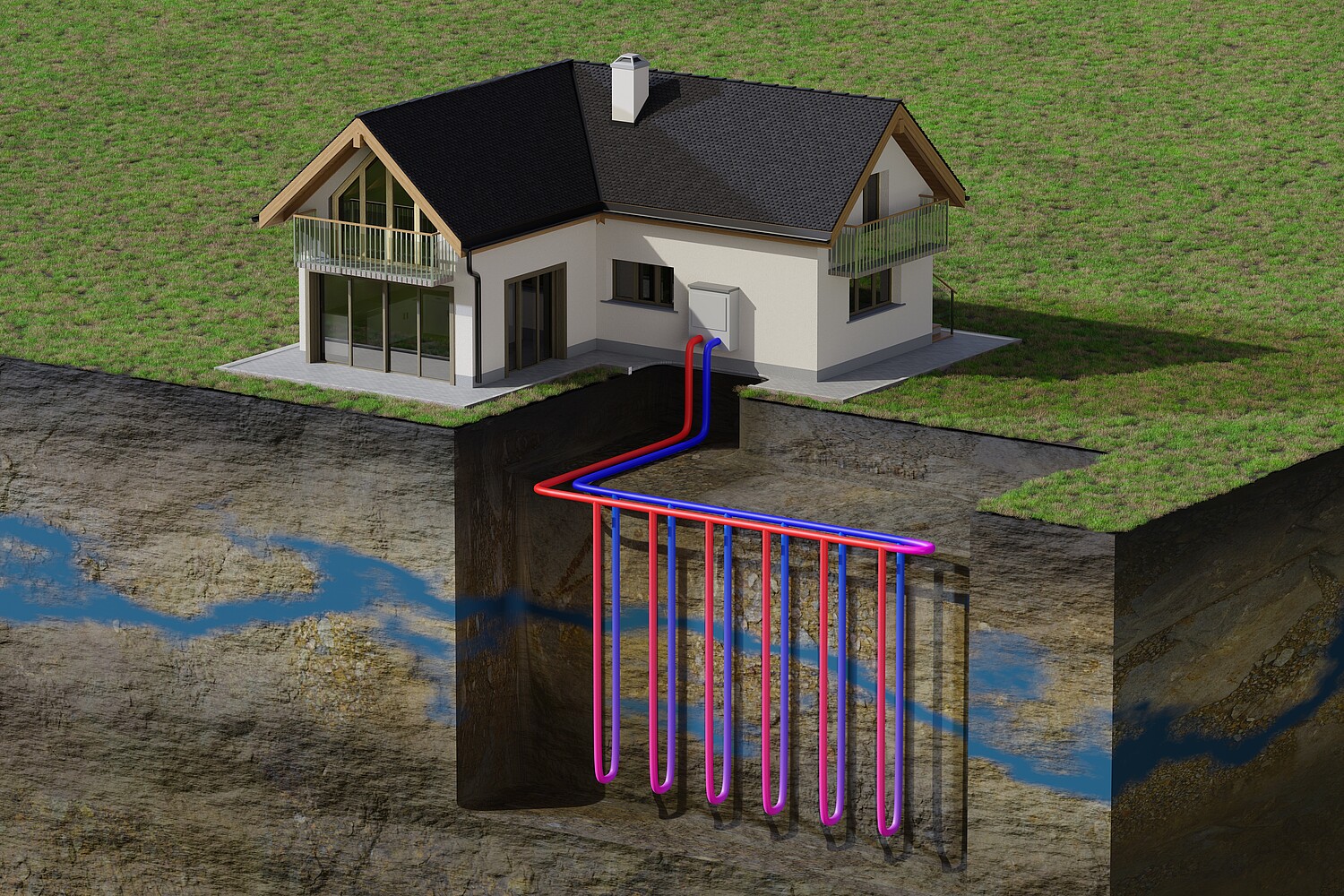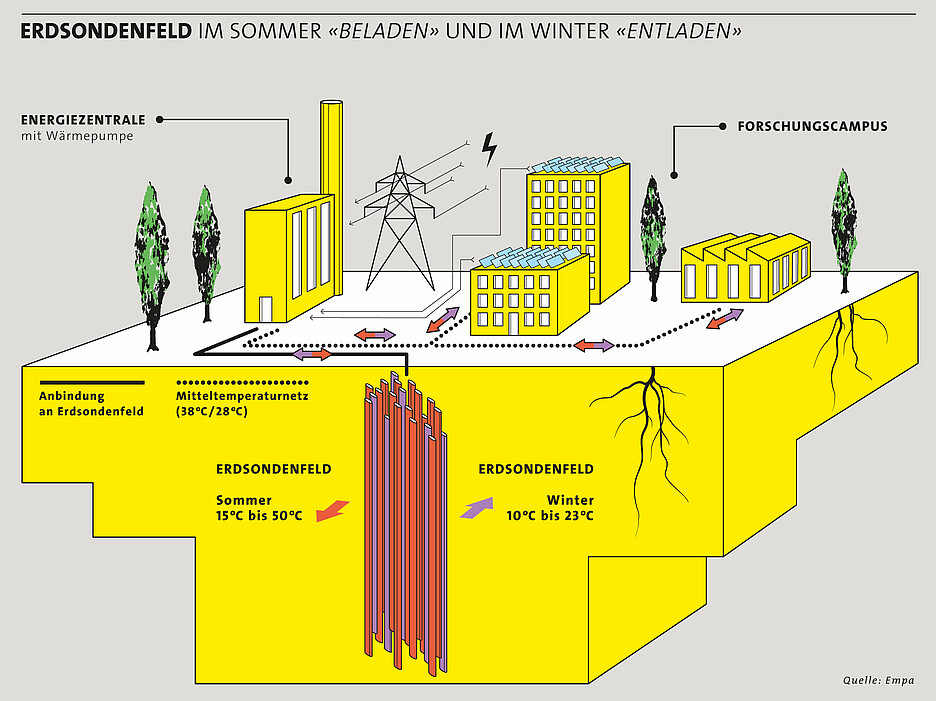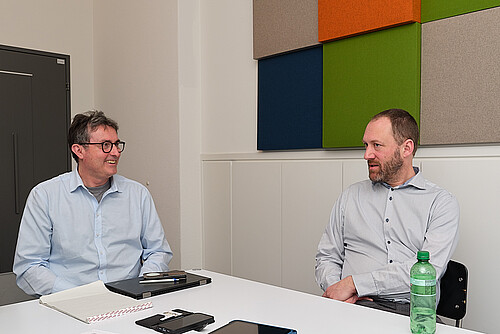
The ground beneath our feet as the energy storage of the future
In order to reduce CO₂ emissions and curb climate change, it will be essential to expand renewable energies. However, without storage for surplus solar or wind power, it will not be possible to turn the energy transition into reality. An important part of the solution may in fact lie untapped beneath our feet.
When we talk about energy storage, the first thing most people think of are batteries. Yet these have significant disadvantages. The production of the batteries themselves devours large amounts of energy before the end-product can then store electricity. They are also expensive: a standard 100-kilowatt-hour battery in a large electric car – equivalent to the average energy consumption of a Swiss single-family home over five days – currently costs around CHF 15,000. Batteries are thus far from suitable for storing electrical energy for thousands, let alone millions of households.
Seasonal load shifting
However, if the energy transition is to be realised and Switzerland is to become carbon neutral by 2050, huge energy storage systems will be essential. This is because the largest amounts of energy are produced during the summer months, but far more energy is consumed in winter. For the past seven years, Luca Baldini, Co-Head of the Institute for Building Technologies and Processes (IBP) at the ZHAW, has been researching how surplus energy generated during the summer can be stored for the winter, a process that experts refer to as seasonal load shifting. He specialises in the area of building energy systems and thermal energy storage, including by regenerating the ground through the use of geothermal probes.

“We need to regenerate the ground. Put simply, the energy that you take out has to be put back in.”
“In principal, geothermal probes are nothing new: you drill a deep hole and use the earth’s mass as a huge thermal storage system that is drawn on to heat buildings or entire complexes and supply them with hot water. For large-scale projects in particular, regenerating the ground is extremely important and offers great potential.” As Baldini explains, if you continuously extract heat from the ground via a geothermal probe, the borehole’s area of influence also grows over the years in a fashion similar to a funnel. As a result, the ground cools and at some point heat is also extracted from neighbouring plots of land. “To prevent this, you have to actively manage the ground. In other words, regenerate it. Put simply, the energy that you take out has to be put back in.” This could be achieved, for instance, by using surplus renewable energy generated in the summer, such as waste heat from cooling processes, direct heat from solar collectors or heat from ambient air collectors. “This greatly improves the efficiency of heat pumps during the winter months and thus also markedly reduces the CO₂ emissions of such systems,” explains Baldini.
High-temperature geothermal probe storage
The SWEET DeCarbCH research project, which Baldini and his team are involved in together with numerous other universities and institutes with the support of the Swiss Federal Office of Energy, goes one step further. Instead of only putting as much energy into the ground as was originally extracted, the storage temperature is increased during the summer months. “In doing so, we bring the ground to a higher operating temperature, which is the reason we refer to it as high-temperature geothermal probe storage.”

“Technically speaking, a great deal is possible. At present, however, the regulatory hurdles are often still too high for specific projects.”
The advantage of this increase in the original ground temperature is that the surplus renewable energy generated in summer can be saved for a later time and used when it is needed most, namely in the cold winter months. According to Baldini, the potential is huge: “Winter electricity demand across Switzerland can be reduced by up to three terawatt hours by using large heat storage systems and through consistent geothermal probe regeneration. This would equate to approximately one-third of the amount of electricity that it is estimated will have to be imported in the winter of 2050.”
Switzerland’s first high-temperature geothermal probe field
In another research project, the Innosuisse flagship SwissSTES (Swiss Seasonal Thermal Energy Storage Action Plan and Implementation) in which the ZHAW acts as the lead, the goal is to develop planning aids and design tools for the practical use of such high-temperature geothermal probe storage systems, among other things.

Initial field projects are already underway: on the Empa campus in Dübendorf, the first Swiss high-temperature geothermal field is currently being built. It will consist of 144 geothermal probes that are being laid at a depth of up to 100 metres, with each positioned three to five metres apart. Baldini was heavily involved in preparing and planning the project. Once in operation, the geothermal storage facility will supply a large part of the Empa campus with stored energy from the summer. According to him, it is possible that even old tunnels or military bunkers could in future be used as long-term thermal storage facilities. “Technically speaking, a great deal is possible. At present, however, the regulatory hurdles are often still too high for specific projects and the monetary incentive is too small.”
Investments in the future
While awareness is growing among those in the worlds of politics and industry that thermal storage systems are important for the energy transition and can assume a system-supporting function, Baldini believes there is still some way to go. “Even today, significant opportunities to fully exploit this potential are being missed and people are instead turning to the limited resource of biomass.” He is therefore calling for better incentive systems: “Energy is still far too cheap today. Investments in thermal storage are investments in the future, both in terms of security of supply and the decarbonisation of our energy system. In future, it should therefore not be about everyone trying to optimise their own building and bank balance, but rather about making a contribution to the system and, for example, considering their home with an energy storage system as part of the overall energy system.”


0 Comments
Be the First to Comment!